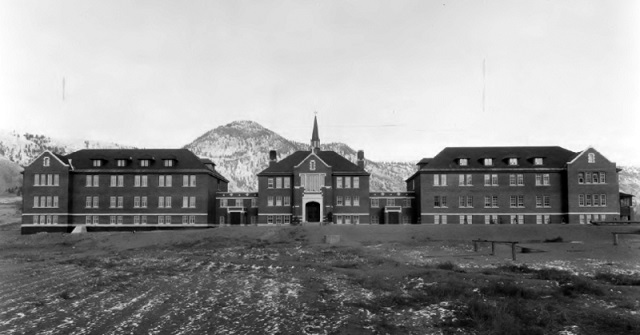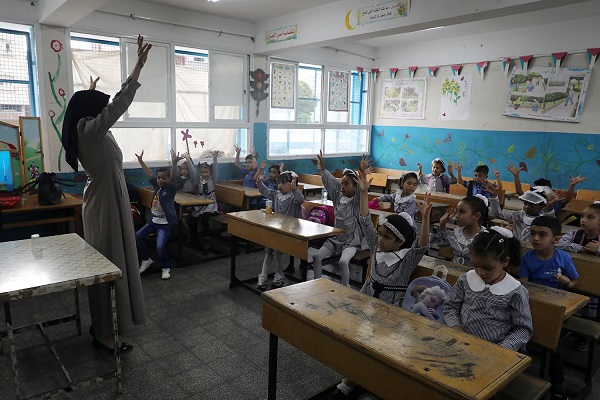Frontier Centre for Public Policy
Canada’s Indigenous burial hoax is still very much alive

From the Frontier Centre for Public Policy
The Kamloops “confirmation” – growing more inconclusive all the time – consisted solely of signs of sub-surface soil irregularities: GPR cannot detect human or other organic material, and is only reliable in finding graves in known cemeteries.
History shows that many hoaxes, fake news stories, and conspiracy theories have proven nearly unassailable, even when proven false. So far, it seems a British Columbia burial canard will be added to this list.
The assertion that thousands of Indian Residential School children are buried in unmarked graves across the country, many of them victims of genocide, has been bandied about for decades. Its current promotion skyrocketed in mid-2021 following an Indigenous media release that was heard around the world:
May 27, 2021, Kamloops – It is with a heavy heart that Tk’emlúps te Secwé pemc Kukpi7 (Chief) Rosanne Casimir confirms an unthinkable loss that was spoken about but never documented by the Kamloops Indian Residential School. This past weekend, with the help of a ground penetrating radar (GPR) specialist, the stark truth of the preliminary findings came to light – the confirmation of the remains of 215 children who were students of the Kamloops Indian Residential School.
Although this claim and others like it are slowly being exposed as false, most Canadians still believe them.
This assertion is one of the findings of a February 2024 Macdonald-Laurier Institute research report that found “by a 79 to 21 ratio, respondents believed that ‘215 Indigenous residential school children were buried in a mass grave on school grounds in Kamloops, BC,’” a story lacking factual or historical evidence “but which most media and virtually all politicians have been reluctant to contradict.”
The Kamloops Burial Hoax
The Kamloops “confirmation” – growing more inconclusive all the time – consisted solely of signs of sub-surface soil irregularities: GPR cannot detect human or other organic material, and is only reliable in finding graves in known cemeteries.
Still, immediately following the Kamloops announcement, there were angry vigils, public displays of grief and shame, solidarity speeches, promises to revolutionize society, and the burning down of dozens of predominantly Roman Catholic churches.
The furore attending the Kamloops discovery accelerated as later findings were announced in other provinces, with the number of purportedly identified graves soon exceeding 2,000. Frequently heard among activists was the cry that these announcements were proof of a hidden “Holocaust” or “Final Solution” perpetrated against Aboriginal students by Canadians working in residential schools. The Kamloops school was alleged to have been a “concentration camp” and the 2021 “burials” evidence that there had been a horrific crime.
Evidence Challenging the Hoax
Entrenched public opinion on what increasingly looks like a burial hoax was damaged on August 18, 2023, when the 14 closely spaced soil disturbances detected using GPR in the basement of the Roman Catholic church on the site of the former Pine Creek Residential School were found to contain animal bones and debris, not human remains.
These findings were preceded by several other inconclusive discoveries.
In August 2021, a team of researchers in Shubenacadie, Nova Scotia, conducted an excavation at the former Shubenacadie Residential School in search of clandestine burials, but to no avail. Two months later, a search was conducted for unmarked graves on the site of the former Camsell Indian Hospital in Edmonton. The facility treated Indigenous people, many of whom suffered from tuberculosis, and some Indigenous leaders claimed that the dig would uncover patients that had been buried there, but no such evidence was discovered.
One discovery still making headlines is the unearthing of child-sized skeletons in a reputed “mass grave,” most likely the result of repeated accidental excavation and haphazard reburial by community grave diggers in the community cemetery on Alberta’s Saddle Lake Cree Indian Reserve. Without a shred of evidence, community members have attributed the death of some of these children to murder at the hands of a school official that was never reported to the police.
That there are no missing or secretly buried students who attended the reserve’s Indian Residential School is proven by the absence of relatives in the past or present searching for loved ones who never returned home. By comparison, in all of Canada, only two distant relatives have been identified as looking for their ancestors. In both cases, the children’s death certificates were found “buried” in the provincial archives whose records showed they were buried correctly on their home reserves.
Two easily located students’ records are surely vastly different from the “15,000 to 25,000 … maybe even more” children Murray Sinclair, former Chair of the Truth and Reconciliation Commission of Canada, has claimed may be missing.
It is becoming increasingly clear that the Kamloops claim, and the many copycat allegations it fomented, are fallacious. More commentators are awaking to the “mass grave” propaganda, even though the Canadian mainstream media barely responded to the Pine Creek discovery of presumptive graves containing no human remains, an important reason this hoax is still very much alive.
Indigenous Elites Support the Hoax
Among the most prominent of many Indigenous perpetrators of these inflammatory claims of murder, mass graves, and even genocide has been RoseAnne Archibald, former National Chief of the Assembly of First Nations, Canada’s largest and best-known Indigenous lobbying group.
At a July 15, 2021, Kamloops Indian Band public presentation, Archibald maintained that the Kamloops case told the world “how 215 innocent children died and were buried in unmarked graves” and that this “crime against humanity” constituted “genocide.”
Completely ignoring the caution of all the known researchers conducting these band-sponsored GPR searches, Archibald added that “this ground penetrating technology is revealing evidence, undisputable proof, that crimes were committed.”
In an interview broadcast by the BBC on August 4, 2021, Archibald charged that Canada’s Indian Residential Schools were “designed to kill” Indigenous children. “And we are seeing proof of that,” she said. “1,600 children, innocent children, have been recovered so far…. We are going to be in the thousands upon tens of thousands of children found. I am not sure how you can say that the recovery of that many little children does not signify what it is – genocide.”
Chief Archibald failed to mention that not a single child’s body “has been recovered so far” or that three years later, no bodies have been exhumed.
A lack of verified evidence of children buried in unmarked graves, some supposedly after priests murdered them, has done nothing to deter the federal government from funding several lavish programmes meant to continue this effort. One of these initiatives was the August 10, 2021, announcement of the allocation of $321 million to help Indigenous communities search burial sites at former residential schools and to support survivors and their communities.
Such programmes have doubtless hardened the public opinion expressed in the Macdonald-Laurier Institute poll. Allied beliefs discovered by the study are also at work: 54 percent of all respondents consider the legacy of Indigenous colonialization to be a problem today; 55 percent vs. 45 percent believe that Indigenous peoples should have a unique status because they were here first; by 48 percent for to 41 percent against, Canadians believe the harm from Indigenous residential schools will continue rather than be resolved; and 19 percent of Canadians think children at residential schools were “purposefully killed” with another 39 percent saying that children also died of neglect.
But the most critical determinant of the exceptionally high belief in the “killing field” at the Kamloops residential school lies in “political culture in Canada,” according to the study: “Much seems to come down to the culturally left-liberal political culture in Canada. That is, the elite norms that hold sway in the media and among mainstream politicians are predominantly culturally leftist.”
As the report says: “It is well established that the media and politicians can cue the issues they want voters to focus on, making decisions to elevate some questions and ignore others.”
This obvious assertion allowed the Macdonald-Laurier Institute report to argue that:
Canadians’ relatively high trust in institutions and cultural elites grants considerable latitude to them to frame the issues that people talk about while neglecting other questions…. There is no better illustration of this than the Kamloops mass graves question, where the code of silence practiced by the media and mainstream political parties has resulted in a clear majority of the public believing this false account.
On the Indigenous side, the Kamloops discovery, and its promise of lots of money, quickly unleashed a flood of similar GPR searches across Canada. To date, the unmarked graves are presumed to hold the remains of mainly unknown and unaccounted for individuals, primarily children, at 26 sites that have been identified since 1974[RC1] .
The allocation of funds to search for graves was followed in June 2022 by appointing an investigator to work with Indigenous communities and the government to propose changes in federal laws, policies, and practices related to unmarked graves at residential schools.
Kimberly Murray, former Executive Director of the Truth and Reconciliation Commission of Canada, was given a two-year appointment as Canada’s “independent special interlocutor for missing children, unmarked graves, and burial sites associated with the Indian Residential Schools.”
Murray’s appointment was simply one part of a campaign, whether deliberately organized or not, to label Canada as a genocidal country long engaged in the systematic murder of Indigenous children whose remains were dumped into mass graves.
Attempts to Stop Hoax Challengers
On June 16, 2023, Murray released an interim report arguing “urgent consideration” should be given to legal mechanisms to combat what activists have termed “residential school denialism.”
Unsurprisingly, her “opening words” in the report stated:
… my role is to give voice to the children. It is not to be neutral or objective – it is to be a fierce and fearless advocate to ensure that the bodies and Spirits of the missing children are treated with the care, respect, and dignity that they deserve” even if that “conflicts with my responsibility to function independently and impartially, in a non-partisan and transparent way.
This attack on the fundamental precepts of objective search for truth based on reason, logic, and scientific evidence rooted in a scientific paradigm that clashes with Indigenous ways of knowing gave her leave to label genocide denial as an “attack” on her version of the truth whenever there were announcements of the discovery of possible unmarked graves.
Moral certainty based on Indigenous ways of knowing, not objective evidence based on science, allowed Kimberly Murray to state that the Canadian government has a role in combatting “denialism,” an inflammatory distortion of what is simply scientific scrutiny, by giving “urgent consideration” to the legal tools that already exist to address the problem, including civil and criminal sanctions.
“They have the evidence. The photos of burials. The records that prove that kids died. It is on their shoulders,” Murray told a crowd gathered on the Cowessess Indian Reserve in Saskatchewan on June 16, 2023.
But there is no photographic evidence of children buried beside the shuttered Kamloops Indian Residential School nor at any of the other former Indigenous schools in Canada.
The only photographic evidence shows typical church burials and thousands of schoolchildren engaged in everyday activities. As for the records, they reveal that the few residential school children who died at the schools were buried in school cemeteries beside school staff members or the nearest reserve cemetery. But most deceased children were interred on their home reserves. All of them received a proper Christian burial after they died, most succumbing to contagious diseases like tuberculosis over which Indigenous people had little natural immunity.
Several of those labelled denialists have argued that there are few missing students, only missing records about their school attendance and death. On March 21, 2023, Murray inadvertently confirmed this assertion in her testimony before the federal government’s Standing Senate Committee on Indigenous Peoples when she said:
The family doesn’t know where their loved one is buried. They were taken to a sanatorium, an Indian residential school. They were just told … that they died. I can get the name of that [missing] individual, I can log into the National Centre for Truth and Reconciliation, find the name of the student, find a record, which will lead me down to another record, which will lead me to Ancestry.com. Why are families having to go to my office to find the death certificate of their loved one on Ancestry.com when the provinces and territories won’t just provide those records?
And then those records will lead you to where they’re buried, hundreds of miles away from their home community. We are now seeing families going to cemeteries. I get this a lot. The children aren’t missing; they’re buried in the cemeteries. They’re missing because the families were never told where they’re buried. Every Indigenous family needs to know where their child is buried. When we find that, and we know that they’re going to have a little bit of closure now, they know the truth and they have some answers, that’s what keeps us going. [emphasis added].
Even though there is little evidence that thousands of children’s deaths were not reported to their parents, and lots of evidence that this is not true, including the refusal of the National Centre for Truth and Reconciliation to remove the names of children whose cause of death and place of burial have been found, from its Memorial Register, a list now totalling over 4,100 named and unnamed “children who never returned home from residential schools.”
Murray’s statement contradicts the established public narrative about missing children. None of these facts have ever been communicated to the public by the mainstream media.
The latest anti-denial effort emanated from the Canadian Senate Standing Committee on Indigenous Peoples, which released a 30-page report on July 19, 2023, titled “Honouring the Children Who Never Came Home: Truth, Education and Reconciliation.” The study recommends “that the Government of Canada take every action necessary to combat the rise of residential school denialism.”
According to lawyer John Carpay, president of the Justice Centre for Constitutional Freedoms:
The use of state resources to promote one opinion on a scientific or historical matter is nakedly totalitarian. Apart from that, the senators’ aggressive language calling on government to “take every action necessary” suggests that it would be okay for the government to punish the likes of Michelle Stirling, Mark DeWolf, and others who dare to disagree with the dominant narrative.
The report fails to define “denialism” yet claims it “serves to distract people from the horrific consequences of Residential Schools and the realities of missing children, burials, and unmarked graves.” This omission suggests that “denialism” means disagreeing with the dominant narrative that Indian Residential Schools were houses of horror marked by racism and genocide.
Decades of an Aboriginal blood libel assertions hang over all these claims, with an army of activists and their supporters acting as its eager propagandists. It is long past time to find the underlying cause of this fake news by exhuming the reputed unmarked graves and identifying any remains they might contain. If that never happens, Canadians will be paying vast amounts forever to keep this hoax about missing and murdered Indigenous children alive.
Hymie Rubenstein is editor of REAL Indigenous Report and a retired professor of anthropology, the University of Manitoba.
Automotive
Canada’s EV Mandate Is Running On Empty

From the Frontier Centre for Public Policy
At what point does Ottawa admit its EV plan isn’t working?
Electric vehicles produce more pollution than the gas-powered cars they’re replacing.
This revelation, emerging from life-cycle and supply chain audits, exposes the false claim behind Ottawa’s more than $50 billion experiment. A Volvo study found that manufacturing an EV generates 70 per cent more emissions than building a comparable conventional vehicle because battery production is energy-intensive and often powered by coal in countries such as China. Depending on the electricity grid, it can take years or never for an EV to offset that initial carbon debt.
Prime Minister Mark Carney paused the federal electric vehicle (EV) mandate for 2026 due to public pressure and corporate failures while keeping the 2030 and 2035 targets. The mandate requires 20 per cent of new vehicles sold in 2026 to be zero-emission, rising to 60 per cent in 2030 and 100 per cent in 2035. Carney inherited this policy crisis but is reluctant to abandon it.
Industry failures and Trump tariffs forced Ottawa’s hand. Northvolt received $240 million in federal subsidies for a Quebec battery plant before filing for bankruptcy. Lion Electric burned through $100 million before announcing layoffs. Arrival, a U.K.-based electric van and bus manufacturer, collapsed entirely. Stellantis and LG Energy Solution extracted $15 billion for Windsor. Volkswagen secured $13 billion for St. Thomas.
The federal government committed more than $50 billion in subsidies and tax credits to prop up Canada’s EV industry. Ottawa defended these payouts as necessary to match the U.S. Inflation Reduction Act, which offers major incentives for EV and battery manufacturing. That is twice Manitoba’s annual operating budget. Every Manitoban could have had a two-year tax holiday with the public money Ottawa wasted on EVs.
Even with incentives, EVs reached only 15 per cent of new vehicle sales in 2024, far short of the mandated levels for 2026 and 2030. When federal subsidies ended in January 2025, sales collapsed to nine per cent, revealing the true level of consumer demand. Dealer lots overflowed with unsold inventory. EV sales also slowed in the U.S. and Europe in 2024, showing that cooling demand is a broader trend.
As economist Friedrich Hayek observed, “The curious task of economics is to demonstrate to men how little they really know about what they imagine they can design.” Politicians and bureaucrats cannot know what millions of Canadians know about their own needs. When federal ministers mandate which vehicles Canadians must buy and which companies deserve billions, they substitute the judgment of a few hundred officials for the collective wisdom of an entire market.
Bureaucrats draft regulations that determine the vehicles Canadians must purchase years from now, as if they can predict technology and consumer preferences better than markets.
Green ideology provided perfect cover. Invoke a climate emergency and fiscal responsibility vanishes. Question more than $50 billion in subsidies and you are labelled a climate denier. Point out the environmental costs of battery production, and you are accused of spreading misinformation.
History repeatedly teaches that central planning always fails. Soviet five-year plans, Venezuela’s resource nationalization and Britain’s industrial policy failures all show the same pattern. Every attempt to run economies from political offices ends in misallocation, waste and outcomes opposite to those promised. Concentrated political power cannot ever match the intelligence of free markets responding to real prices and constraints.
Markets collect information that no central planner can access. Prices signal scarcity and value. Profits and losses reward accuracy and punish error. When governments override these mechanisms with mandates and subsidies, they impair the information system that enables rational economic decisions.
The EV mandate forced a technological shift and failed. Billions in subsidies went to failing companies. Taxpayers absorbed losses while corporations walked away. Workers lost their jobs.
Canada needs a full repeal of the EV mandate and a retreat from PMO planners directing market decisions. The law must be struck, not paused. The contrived 2030 and 2035 targets must be abandoned.
Markets, not cabinet ministers, must determine what technologies Canadians choose.
Marco Navarro-Genie is vice-president of research at the Frontier Centre for Public Policy and co-author, with Barry Cooper, of Canada’s COVID: The Story of a Pandemic Moral Panic (2023).
Business
Is Carney Falling Into The Same Fiscal Traps As Trudeau?

From the Frontier Centre for Public Policy
By Jay Goldberg
Rosy projections, chronic deficits, and opaque budgeting. If nothing changes, Carney’s credibility could collapse under the same weight.
Carney promised a fresh start. His budget makes it look like we’re still stuck with the same old Trudeau playbook
It turns out the Trudeau government really did look at Canada’s economy through rose-coloured glasses. Is the Carney government falling into the same pattern?
New research from the Frontier Centre for Public Policy shows that federal budgets during the Trudeau years “consistently overestimated [Canada’s] fiscal health” when it came to forecasting the state of the nation’s economy and finances over the long term.
In his research, policy analyst Conrad Eder finds that, when looking specifically at projections of where the economy would be four years out, Trudeau-era budgets tended to have forecast errors of four per cent of nominal GDP, or an average of $94.4 billion.
Because budgets were so much more optimistic about long-term growth, they consistently projected that government revenue would grow at a much faster pace. The Trudeau government then made spending commitments, assuming the money would be there. And when the forecasts did not keep up, deficits simply grew.
As Eder writes, “these dramatic discrepancies illustrate how the Trudeau government’s longer-term projections consistently underestimated the persistence of fiscal challenges and overestimated its ability to improve the budgetary balance.”
Eder concludes that politics came into play and influenced how the Trudeau government framed its forecasts. Rather than focusing on the long-term health of Canada’s finances, the Trudeau government was focused on politics. But presenting overly optimistic forecasts has long-term consequences.
“When official projections consistently deviate from actual outcomes, they obscure the scope of deficits, inhibit effective fiscal planning, and mislead policymakers and the public,” Eder writes.
“This disconnect between projected and actual fiscal outcomes undermines the reliability of long-term planning tools and erodes public confidence in the government’s fiscal management.”
The public’s confidence in the Trudeau government’s fiscal management was so low, in fact, that by the end of 2024 the Liberals were polling in the high teens, behind the NDP.
The key to the Liberal Party’s electoral survival became twofold: the “elbows up” rhetoric in response to the Trump administration’s tariffs, and the choice of a new leader who seemed to have significant credibility and was disconnected from the fiscal blunders of the Trudeau years.
Mark Carney was recruited to run for the Liberal leadership as the antidote to Trudeau. His résumé as governor of the Bank of Canada during the Great Recession and his subsequent years leading the Bank of England seemed to offer Canadians the opposite of the fiscal inexperience of the Trudeau years.
These two factors together helped turn around the Liberals’ fortunes and secured the party a fourth straight mandate in April’s elections.
But now Carney has presented a budget of his own, and it too spills a lot of red ink.
This year’s deficit is projected to be a stunning $78.3 billion, and the federal deficit is expected to stay over $50 billion for at least the next four years.
The fiscal picture presented by Finance Minister François-Philippe Champagne was a bleak one.
What remains to be seen is whether the chronic politicking over long-term forecasts that plagued the Trudeau government will continue to be a feature of the Carney regime.
As bad as the deficit figures look now, one has to wonder, given Eder’s research, whether the state of Canada’s finances is even worse than Champagne’s budget lets on.
As Eder says, years of rose-coloured budgeting undermined public trust and misled both policymakers and voters. The question now is whether this approach to the federal budget continues under Carney at the helm.
Budget 2025 significantly revises the economic growth projections found in the 2024 fall economic statement for both 2025 and 2026. However, the forecasts for 2027, 2028 and 2029 were left largely unchanged.
If Eder is right, and the Liberals are overly optimistic when it comes to four-year forecasts, then the 2025 budget should worry Canadians. Why? Because the Carney government did not change the Trudeau government’s 2029 economic projections by even a fraction of a per cent.
In other words, despite the gloomy fiscal numbers found in Budget 2025, the Carney government may still be wearing the same rose-coloured budgeting glasses as the Trudeau government did, at least when it comes to long-range fiscal planning.
If the Carney government wants to have more credibility than the Trudeau government over the long term, it needs to be more transparent about how long-term economic projections are made and be clear about whether the Finance Department’s approach to forecasting has changed with the government. Otherwise, Carney’s fiscal credibility, despite his résumé, may meet the same fate as Trudeau’s.
Jay Goldberg is a fellow with the Frontier Centre for Public Policy.
-

 Automotive1 day ago
Automotive1 day agoTrump Deals Biden’s EV Dreams A Death Blow
-

 Focal Points2 days ago
Focal Points2 days agoPharma Bombshell: President Trump Orders Complete Childhood Vaccine Schedule Review
-

 Alberta2 days ago
Alberta2 days agoPremier Smith: Canadians support agreement between Alberta and Ottawa and the major economic opportunities it could unlock for the benefit of all
-

 Censorship Industrial Complex2 days ago
Censorship Industrial Complex2 days agoFrances Widdowson’s Arrest Should Alarm Every Canadian
-

 Opinion2 days ago
Opinion2 days agoCountry music star Paul Brandt asks Parliament to toughen laws against child porn
-

 Automotive1 day ago
Automotive1 day agoCanada’s EV Mandate Is Running On Empty
-

 Business1 day ago
Business1 day agoWhy Does Canada “Lead” the World in Funding Racist Indoctrination?
-

 Business19 hours ago
Business19 hours agoLoblaws Owes Canadians Up to $500 Million in “Secret” Bread Cash



